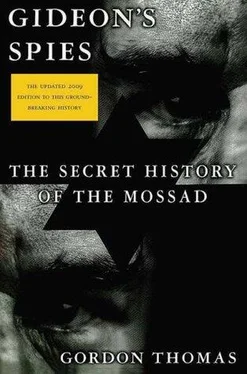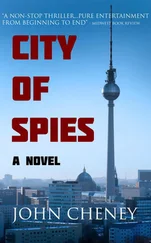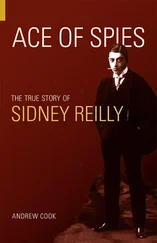Gordon Thomas - Gideon's Spies
Здесь есть возможность читать онлайн «Gordon Thomas - Gideon's Spies» весь текст электронной книги совершенно бесплатно (целиком полную версию без сокращений). В некоторых случаях можно слушать аудио, скачать через торрент в формате fb2 и присутствует краткое содержание. Город: New York, Год выпуска: 2009, ISBN: 2009, Издательство: Thomas Dunne Books, Жанр: История, на английском языке. Описание произведения, (предисловие) а так же отзывы посетителей доступны на портале библиотеки ЛибКат.
- Название:Gideon's Spies
- Автор:
- Издательство:Thomas Dunne Books
- Жанр:
- Год:2009
- Город:New York
- ISBN:978-0-312-53901-6
- Рейтинг книги:4 / 5. Голосов: 1
-
Избранное:Добавить в избранное
- Отзывы:
-
Ваша оценка:
- 80
- 1
- 2
- 3
- 4
- 5
Gideon's Spies: краткое содержание, описание и аннотация
Предлагаем к чтению аннотацию, описание, краткое содержание или предисловие (зависит от того, что написал сам автор книги «Gideon's Spies»). Если вы не нашли необходимую информацию о книге — напишите в комментариях, мы постараемся отыскать её.
Gideon’s Spies
Gideon's Spies — читать онлайн бесплатно полную книгу (весь текст) целиком
Ниже представлен текст книги, разбитый по страницам. Система сохранения места последней прочитанной страницы, позволяет с удобством читать онлайн бесплатно книгу «Gideon's Spies», без необходимости каждый раз заново искать на чём Вы остановились. Поставьте закладку, и сможете в любой момент перейти на страницу, на которой закончили чтение.
Интервал:
Закладка:
Unusually, a key role had been assigned to an outsider, a much respected doctor, Levi-Arie Shapiro, a consultant anesthetist and director of the intensive care unit at Hasharon Hospital in Tel Aviv. He had been recruited by Alexander Barak, a katsa who had appealed to the doctor’s patriotism. The doctor agreed to travel to London and spend the thousand dollars Barak had given him to pay for medical equipment, which included anesthetics and an endotracheal tube. He would receive further instructions in London. Shapiro refused to accept a fee for his services, saying he was proud to serve Israel. Another katsa, Felix Abithol, had arrived in London on a flight from Amsterdam on July 2. He checked into the Russell Square Hotel. His first instruction to the head of the Nigerian team, Major Yusufu, was to rent a transit van. One of Yusufu’s men chose one that was a bright canary yellow color. That may well have been the moment the plan started to unravel.
Late in the evening of July 3, a Nigerian Airways 707 freighter landed at Stansted Airport, thirty miles northeast of London. It had flown from Lagos empty. The pilot informed the airport authorities he had come to collect diplomatic baggage from the London embassy. Traveling with the aircrew were several Nigerian security men who openly identified themselves and said they were there to protect the baggage. Their presence was reported to Scotland Yard’s Special Branch. There had been several claims in the past month that the Lagos military regime was threatening exiles in London. The security men were told they must not leave the airport. Apart from visits to the terminal coffee shop, they remained on board the aircraft.
Around midmorning the next day, the canary yellow van drove out of a garage in Notting Hill Gate that had been rented by one of the Nigerians. At the wheel was Yusufu. In the back squatted Dr. Shapiro beside a crate. Crouching with him were Barak and Abithol. At noon out at Stansted, the 707 captain filed a departure time for Lagos of three o’clock that afternoon. The flight manifest listed the cargo as two crates of “documentation” for the Ministry of External Affairs in Lagos. The paperwork claimed diplomatic immunity for both containers.
Shortly before noon, the van drove through traffic and parked outside the house in Dorchester Terrace. Soon afterward, Umaru Dikko emerged on his way to meet a friend for lunch at a nearby restaurant. Watching from a window was his private secretary, Elizabeth Hayes. As she turned away, the back door of the van burst open and “two dark-skinned men grabbed Mr. Dikko and forced him into the back of the van. He just managed to scream something before they jumped in after him and the van was driven away at high speed.”
Recovering, the secretary dialed emergency—999. Within minutes police were on the scene, closely followed by Commander William Hucklesby of Scotland Yard’s Anti-Terrorist Squad. He suspected what had happened. Every port and airport was alerted. For Hucklesby, the situation had its own special difficulties. If Dikko had been kidnapped by the Nigerian regime, that could present tricky political questions. The Foreign Office was alerted, as was Downing Street. Hucklesby was ordered to take what action he thought appropriate.
Shortly before 3:00 P.M. the van arrived at Stansted’s freight terminal. Yusufu waved a Nigerian diplomatic passport at airport customs officers. They watched the two crates being loaded on board the aircraft. One of the officers, Charles Morrow, would recall: “There was something about one of the containers that was just not right. Then I heard noise coming from one. I thought, sod this. Diplomatic immunity or not, I needed to see inside.”
The cases were taken off the plane and brought to a hangar despite Yusufu’s furious protest that they were protected by diplomatic privilege. In the first crate, Umaru Dikko was discovered tied and unconscious from an anesthetic. Sitting beside him was Dr. Shapiro, a syringe in his hand ready to increase Dikko’s drug intake. There was an endotracheal tube in Dikko’s throat to stop him from choking on his own vomit. In the other container crouched Barak and Abithol.
At their trial, both agents stuck stoically to the fiction that they were mercenaries acting on behalf of a group of Nigerian businessmen who wanted to return Dikko to face trial. One of Britain’s most eminent and expensive lawyers, George Carmen, QC, had been retained for their defense. In his closing speech he told the court, “Perhaps the most plausible explanation is that the Israeli intelligence service was never far removed from the entire operation.”
The prosecution offered no evidence to implicate Mossad. It was left to the judge to do so in his summing-up. He told the jury, “The finger of involvement almost certainly points to Mossad.”
Barak received a fourteen-year sentence, Dr. Shapiro and Abithol ten years apiece. Yusufu was given twelve years’ imprisonment. All were subsequently released after remission for good conduct and quietly deported to Israel. As it had for others before them who had served Mossad well, the service made sure they would remain out of the limelight and not have to answer such troubling questions as to whether Dr. Shapiro, who had so flagrantly broken his Hippocratic oath, still practiced medicine—and for whom.
Nahum Admoni was told by MI5 that if there was a further lapse, Mossad would be treated as an unfriendly service. By then the Mossad chief was planning yet another operation designed to remind Britain of who the real enemies were—and at the same time gain sympathy for Israel.
CHAPTER 14
THE CHAMBERMAID’S BOMB
On a cloudless morning in February 1986, two Israeli air force fighter aircraft swooped down on a Libyan-registered Learjet flying from Tripoli to Damascus. The civilian plane was in international airspace, thirty thousand feet over the Mediterranean and about to begin its descent into Syrian airspace. On board were delegates returning from a conference of Palestinian and other radical groups that Mu’ammar Gadhafi had convened to discuss new steps to achieve the Libyan leader’s burning obsession to see Israel driven from the face of the earth.
The sight of the fighters taking up stations on either side of the Learjet created near panic among its fourteen passengers, and for good reason. Four months before, on Tuesday, October 1, 1985, Israeli F-15 fighter-bombers had destroyed the headquarters of the Palestinian Liberation Organization southeast of Tunis, flying a round-trip of almost three thousand miles, which had involved air-to-air refueling and the kind of precise intelligence that always sent a collective shiver throughout the Arab world.
That raid was a direct response to the murder by PLO gunmen of three middle-aged Israeli tourists as they sat aboard their yacht in the Cypriot port of Larnaca only days before, basking in the sunshine of late summer. The killings had occurred on Yom Kippur and, for many Israelis, the slaughter rekindled memories of the onset of the war on the Day of Atonement when the nation itself had been caught as unaware as the tourists.
Despite having endured almost four decades of terrorism, the murders caused widespread horror and fear among Israelis: the tourists had been held for some time on board their boat and allowed to write down their final thoughts before they were killed: first to die was the woman, fatally shot in the stomach. Her two male companions were made to throw her overboard. Then one after another, they were shot at point-blank range in the back of the head.
In the black propaganda war that had long been a feature of the intelligence war between the PLO and Israel, the former claimed that the three victims were Mossad agents on a mission. So well did the PLO plant the story that several European newspapers identified the woman as one of the agents caught in the Lillehammer affair in 1973. That woman was still alive and had long given up her Mossad activities.
Читать дальшеИнтервал:
Закладка:
Похожие книги на «Gideon's Spies»
Представляем Вашему вниманию похожие книги на «Gideon's Spies» списком для выбора. Мы отобрали схожую по названию и смыслу литературу в надежде предоставить читателям больше вариантов отыскать новые, интересные, ещё непрочитанные произведения.
Обсуждение, отзывы о книге «Gideon's Spies» и просто собственные мнения читателей. Оставьте ваши комментарии, напишите, что Вы думаете о произведении, его смысле или главных героях. Укажите что конкретно понравилось, а что нет, и почему Вы так считаете.












